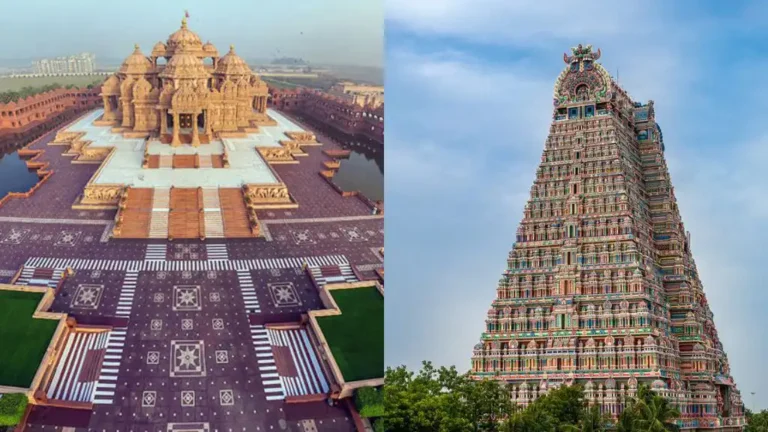The temples of India are a beautiful blend of history, culture, and faith. Their architectural magnificence, spiritual energy, and timeless traditions make them not only important religious sites but also global symbols of India’s rich heritage.
As of 2025, here are the 10 largest and most celebrated temples of India, known for their grandeur, scale, and deep spiritual significance.
1. Sri Ranganathaswamy Temple, Tiruchirappalli, Tamil Nadu
The Sri Ranganathaswamy Temple is considered the largest temple complex in India. Spread across nearly 156 acres, it is dedicated to Lord Vishnu in his reclining form, Ranganatha. The temple boasts 21 majestic gopurams (towering gateways), with the main Rajagopuram standing an impressive 239 feet tall.
This temple is a perfect example of Dravidian architecture, featuring intricate carvings, massive courtyards, and sacred water tanks. Ancient inscriptions and scriptures also highlight its immense historical and religious importance. Pilgrims from all over the world visit here to witness the divine image of Lord Vishnu resting on the serpent Adisesha.
2. Swaminarayan Akshardham Temple, Delhi
A marvel of modern Indian architecture, the Swaminarayan Akshardham Temple stands as a grand tribute to Indian culture and spirituality. Spanning about 100 acres, this temple is famous for its white marble carvings, pink sandstone pillars, and beautifully sculpted deities.
Unlike most temples, Akshardham is not only a place of worship but also an educational and cultural complex that celebrates 10,000 years of Indian civilization. The musical fountain show, light displays, and exhibitions make it a breathtaking experience for visitors from around the globe.
Also Read: Top 10 Richest Temples in Kerala 2025 – Wealth, Donations & History
3. Sri Lakshmi Narayani Temple, Sripuram, Tamil Nadu
Dedicated to Goddess Lakshmi, the Sri Lakshmi Narayani Temple in Sripuram is famous for its gold-plated architecture and divine ambiance. Covering an area of around 40,000 square meters, the temple is surrounded by a star-shaped pathway that symbolises spiritual enlightenment.
During Navratri, millions of devotees visit the temple to seek blessings for prosperity and well-being. Its serene gardens and artistic structure make it one of India’s most beautiful temples dedicated to the Goddess of Wealth.
4. Chhatarpur Temple, Delhi
Located in South Delhi, the Chhatarpur Temple complex spans nearly 70,000 square meters and is dedicated to Goddess Katyayani. It beautifully combines traditional and modern architectural styles, featuring marble halls, grand entrances, and lush gardens.
It is one of the largest temple complexes in India and a popular pilgrimage destination, especially during the Navratri festival, when thousands of devotees come to offer prayers.
5. Prem Mandir, Vrindavan, Uttar Pradesh
For devotees of Lord Krishna, the Prem Mandir in Vrindavan is a symbol of divine love and devotion. Built entirely of white marble, the temple covers around 25,000 square meters and is dedicated to Radha-Krishna.
The carvings and sculptures here depict scenes from Krishna’s life, while the illuminated night view of the temple is simply mesmerizing. Surrounded by gardens, fountains, and a sacred lake, Prem Mandir radiates spiritual beauty and peace.
6. Brihadeeswarar Temple, Thanjavur, Tamil Nadu
The Brihadeeswarar Temple, also known as the “Big Temple,” is one of India’s finest examples of ancient architecture. The temple tower stands 216 feet high and is made entirely of granite. Dedicated to Lord Shiva, it was built by Raja Raja Chola I in the 11th century and is now a UNESCO World Heritage Site.
Its giant Nandi statue, carved from a single stone, and the stunning murals inside make it an architectural and spiritual wonder that continues to inspire awe even after a thousand years.
7. Meenakshi Amman Temple, Madurai, Tamil Nadu
The Meenakshi Amman Temple is one of the most vibrant and artistically rich temples in India. Spanning 45 acres, it is dedicated to Goddess Meenakshi (Parvati) and Lord Sundareswarar (Shiva).
Its 14 massive gopurams, covered with thousands of colorful sculptures of gods, goddesses, and mythical figures, are masterpieces of South Indian art. Millions of devotees visit the temple every year, especially during the Meenakshi Thirukalyanam Festival, which celebrates the divine marriage of Shiva and Parvati.
8. Somnath Temple, Gujarat
Situated on the shores of the Arabian Sea, the Somnath Temple is one of the 12 Jyotirlingas of Lord Shiva and holds immense mythological and historical importance. The temple has been rebuilt several times after being destroyed by invaders, symbolizing the eternal spirit of faith and resilience.
Its main spire rises 155 feet high, and the intricate carvings on its walls display exquisite craftsmanship. Somnath is not just a temple—it is a symbol of India’s enduring devotion and strength.
9. Vaishno Devi Temple, Jammu & Kashmir
Located high in the Trikuta Mountains, the Vaishno Devi Temple is one of the most sacred shrines in India, dedicated to Mata Vaishno Devi. Every year, over 10 million pilgrims trek the 13-kilometer uphill route through forests and caves to reach the holy shrine.
The temple complex covers around 10,000 square meters and radiates divine energy. Devotees believe that Mata Vaishno Devi fulfills the wishes of everyone who visits her with true devotion.
10. Sabarimala Temple, Kerala
Dedicated to Lord Ayyappa, the Sabarimala Temple is nestled in the scenic hills of Kerala’s Western Ghats. It is one of the largest annual pilgrimage sites in the world, attracting millions of devotees, especially during the Makar Sankranti season.
The temple is known for its unique tradition—only men and young boys are allowed to participate in the main rituals, after observing strict vows of purity and discipline for 41 days before the pilgrimage. Surrounded by lush forests, Sabarimala represents simplicity, devotion, and inner strength.
Cultural and Spiritual Significance of Indian Temples
These magnificent temples are not just places of worship—they are living symbols of India’s faith, architecture, and history. Each temple tells its own story through art, inscriptions, and rituals that reflect centuries of devotion and craftsmanship.
From the stone carvings of the Chola era to the marble beauty of modern temples, Indian temples preserve the essence of unity in diversity. They are social and cultural centers that bring people together, celebrating festivals, traditions, and the eternal connection between the human and the divine.
Conclusion
India’s grand temples are not only architectural wonders but also the heart of its spiritual identity. Their size, beauty, and sacred aura make them timeless landmarks of devotion and artistry. Visiting these temples is not just a journey—it is a soulful experience that brings peace, reflection, and connection to something greater than oneself.
These ancient marvels stand as proud reminders of India’s thousand-year-old heritage, its artistic brilliance, and the enduring power of faith. If you ever travel across India, make sure to visit these temples—they are not merely monuments, but the living soul of Indian civilization.


